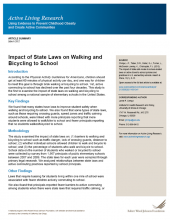We are pleased to announce an exciting new alliance between Active Living Research and GP RED to co-host and coordinate...
Impact of State Laws on Walking and Bicycling to School
The Challenge: According to the Physical Activity Guidelines for Americans, children should get at least 60 minutes of physical activity per day, and one way for children to meet this goal is through brisk walking or bicycling to school. Yet, active commuting to school has declined over the past four decades.
Make an impact: State laws can help increase children’s walking and bicycling to school, which will contribute to children’s overall physical activity.
What the findings are about: This study examines the impact of state laws on walking and bicycling to school among a national sample of elementary schools in the United States.
- Some types of state laws, such as those requiring crossing guards, speed zones and traffic calming around schools, were linked with more principals reporting that more students were allowed to walk/bike to school and fewer principals reporting that no students walked/bicycled to school.
- State policymakers should consider adopting laws that are associated with increased walking and bicycling to school among students, such as those requiring crossing guards, speed zones and traffic calming around schools.
- There is a need for school and community leaders to ensure that the areas around schools are designed to make walking and bicycling to school safe and easy. When routes are safe, bussing distance policies should make active commuting the default option for students living closest to school.
Read the full article: The Impact of State Safe Routes to School-related Laws on Active Travel to School Policies and Practices in U.S. Elementary Schools
- DOWNLOAD "Impact of State Laws on Walking and Bicycling to School" PDF (0.03 MB) Article Summary
STAY UP TO DATE
RECENTLY ADDED TOOLS & RESOURCES
MOVE! A BLOG ABOUT ACTIVE LIVING
The "Active Living Conference" aims to break down research and practice silos and...








